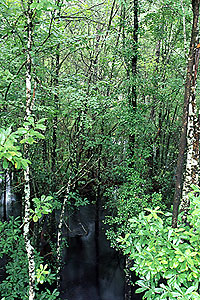|
History Animals & Plants Natural Communities Coastal Dry Uplands Upland Mesic Freshwater Marshes Forested Wetlands Fresh Water Estuaries |
Natural Communities and Habitats:
Forested Wetlands
Fish do grow on trees!
What do wetland forests have to do with fish? Two very important things:
 This cypress dome in Tate's Hell State Forest stands out after the pines around it were clearcut. The man in the lower right is using a net to look for salamander larvae in the standing water in the dome and around its edge. (Tate's Hell State Forest) (photo by Karla Brandt) |
Forested wetlands, generally known as swamps, are the second most widespread natural community type in the ARROW region, next to pinelands. We've split them into two groups: (1) floodplain wetland forests, which are connected to a river or a lake, and (2) isolated wetland forests, which aren't.
(1) Floodplain wetland forests cover a vast amount of territory in the ARROW region. They tailor themselves to the shores of the Chipola, Apalachicola, and Ochlockonee rivers, widening where the rivers widen as they approach the Gulf coast.
The Apalachicola River's floodplain wetland forest is the largest in Florida. It is 71 miles long, 1 to 5 miles wide, and covers 175 square miles. The lowest parts of it are flooded almost all year and have few plants besides the dominant trees, which are often swollen at the base (foresters call this “buttressing”). Shrubs and ground-level plants are few. On slightly higher ground, flooding doesn't last quite as long, and you'll find different communities of trees. It's easy to walk (or wade) through some of these forests, but others are packed with an assortment of vines and shrubs that make great cover for wildlife but unpleasant hiking.
 Hardwood trees shade the dark waters of the Ochlockonee River. (photo by Karla Brandt) |
Typical plants at lower elevations: cypress (in some places, with very few other tree species), black gum, water tupelo, ogeechee tupelo, wax myrtle, dahoon holly
Typical plants at higher elevations: overcup oak, water hickory, diamond-leaf oak and swamp chestnut oak, willow oak, green ash, Florida elm, sweetgum, river birch, red maple, poison ivy, sedges, silverbells, crossvine, loblolly pine, spruce pine
Typical animals include marbled salamander, mole salamander, amphiuma, Southern dusky salamander, two-lined salamander, three-lined salamander, dwarf salamander, slimy salamander, rusty mud salamander, southern toad, cricket frog, bird-voiced treefrog, gray treefrog, bullfrog, river frog, Southern leopard frog, alligator, river cooter, stinkpot, southeastern five-lined skink, broadhead skink, brown water snake, cottonmouth, wood duck, Mississippi kite, red-shouldered hawk, woodcock, barred owl, pileated woodpecker, Carolina wren, parula warbler, prothonotary warbler, hooded warbler, cardinal, towhee, opossum, beaver, wood rat, rice rat, cotton mouse, black bear, raccoon, and bobcat.
Rare plants: Florida merrybells; variable-leaved Indian-plaintain
Rare animals: Swallowtailed kite, Barbour's map turtle
Where to see it:
Apalachicola National Forest
Apalachicola River Wildlife and Environmental Area
Apalachicola Water Management Area
Chipola River Greenway
Edward Ball Wakulla Springs State Park
Florida Caverns State Park
Lake Talquin State Forest
St. Marks National Wildlife Refuge
South Marianna Trail and Canoe Launch
Tate's Hell State Forest
Torreya State Park
Upper Chipola River Water Management Area
(2) Isolated wetland forests collect water from the surrounding landscape. You may find them at the base of a slope, catching water seeping out of the higher ground. Such communities are called baygalls or bay swamps, and they're thick, dark, and crowded with many trunks of tall, straight trees. Usually soggy year round, the soil is deep, acidic peat.
Typical plants: Trees -- Sweetbay, swamp bay, and loblolly bay; under the canopy -- dahoon holly, wax myrtle, royal fern, cinnamon fern, sphagnum moss, lizard's tail, hurrah-bush, doghobble, and possumhaw.
Typical animals: mole salamander, southern dusky salamander, southern mud salamander, opossum, southeastern shrew, short-tailed shrew, marsh rabbit, black bear, raccoon, southern mink, and bobcat
Rare plants: Turk's cap lily, hummingbird flower
Where to see it:
Apalachicola National Forest
Tate's Hell State Forest
Another kind of isolated wetland forest is the cypress dome, a circle of trees with the tallest ones toward the middle. They are found in low spots in pine flatwoods and in places where limestone close to the soil surface has slumped, making a depression. Cypress domes collect water from the surrounding woods, but some are also connected to underground channels. Water stored in cypress domes recharges the aquifer during droughts. This community is often doughnut-shaped, with a treeless circle in the center which may be open water or freshwater marsh.
Typical plants: Cypress, swamp tupelo, slash pine, red maple, poison ivy, Spanish moss, ferns, maidencane, wax myrtle, sawgrass, sphagnum moss, buttonbush
Typical animals: little grass frog, alligator, mud turtle, cottonmouth, wood stork, wood duck, barred owl, pileated woodpecker
Rare plants: Panhandle spiderlily, West's flax, Godfrey's butterwort, hummingbird flower
Rare animals: flatwoods salamander, swallow-tailed kite, wood stork
Where to see it:
Apalachicola National Forest
St. Marks National Wildlife Refuge
Tate's Hell State Forest
Our final wetland forest category, the shrub swamp, usually is evidence of some past disruption of a different wetland category. It could be logging, clearing, a change in drainage that creates a wetland where there wasn't one before; it could be too much fire, or not enough. In the ARROW region, many shrub swamps are tangles of black titi so thick you can barely squeeze sideways between the stems. Shrub swamps are one of the most common wetland types in the region.
Where to see it:
Apalachicola National Forest
Tate's Hell State Forest
Note: The content of the website has not been updated since 2005. The site remains online for it's value as legacy content and is unlikely to be updated.